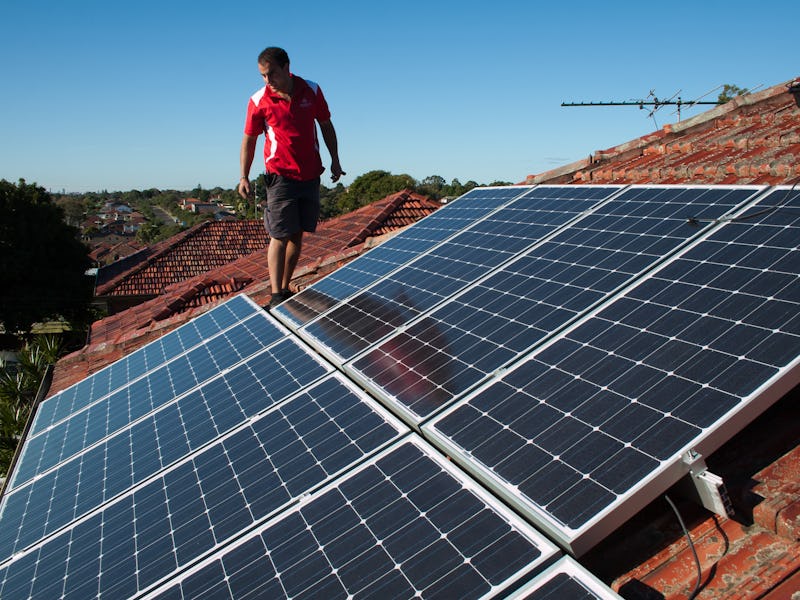Pre-built solar homes could make renewable energy almost 50% cheaper
They could reduce cost per peak watt by nearly 50 percent.

For many homeowners, the idea of finding an affordable solar company and retrofitting their homes with solar panels is too costly and time-consuming. What if homeowners could instead buy a solar-powered house straight off the production line?
These self-powered homes may be coming to a neighborhood near you in a not-so-distant future. On Wednesday the U.S. Department of Energy (DOE) selected Portland, Oregon-based Phase3 Photovoltaics, the company behind the idea of prefabricated solar homes, as one of two winners of the first round competition for the American-Made Solar Prize, worth a total of $3 million dollars.
Phase3 Photovoltaics’ approach has the potential to increase overall attainability and spread of solar-powered homes, particularly for lower-income families, at even cheaper prices than before.
“By incorporating solar cells in the [home] manufacturing process, they are able to provide their solar home solution at a substantially lower cost per watt as compared to traditional installation,” the DOE said in a press release.
Daniel Simmons, assistant secretary for the office of energy efficiency and renewable energy, said in a statement that the goal of the competition is to foster new, American-made innovation in solar energy.
“The American-Made Solar Prize brings together private sector entrepreneurship with expertise at DOE’s national labs to foster next-level innovation in U.S. solar manufacturing,” said assistant secretary Simmons. “These transformative technologies will address critical needs in the U.S. solar industry, and develop impactful solutions for industry to utilize and overcome these challenges.”
In addition to Phase3 Photovoltaics, an Atlanta, Georgia-based company called Solar Inventions also took home top prize for their proposal to design a more ‘stable’ and ‘reliable’ photovoltaic cell. Both companies will receive $500,000 in cash and up to $75,000 to use in conjunction with the DOE’s National Laboratories.
Phase3 Photovoltaics: driving down solar prices
In its proposal video, Phase3 Photovoltaics explains that residential solar power, as it is currently offered, has been restricted to just the upper third of the single-family home market as a result of its costs. Meaning that lower-income households have been unable to access this kind of technology, particularly those making less than $50,000 per year, which the company says makes up 75 percent of the home market.
Instead of working on new ways to retrofit homes with solar power — which even wealthier homeowners can balk at when considering upfront costs — Phase3 Photovoltaics says its chosen to focus on prefabricated homes because there are already 22 million Americans living in such homes and they make up 11 percent of total new homes being built.
“By leveraging pre-fabricated, home building techniques, we estimate that we can reduce installation, operation and balance of system costs close to 60 percent of on-site retrofits,” Phase3 Photovoltaics says in the video.
A graph in their proposal video breaks that down further to show that, compared to 2017 costs of retrofitting a home with solar power, installation and operational costs would be dramatically reduced, bringing the price per peak watt down to almost $1.50 for pre-fab solar homes, compared to nearly $3 per peak watt in retrofitted homes. However, the prices of modules themselves and inverters stayed more or less the same between the two approaches.
Phase3 Photovoltaics says that its prefabricated solar homes can reduce solar power's price per peak watt to roughly 50 percent that of retrofitted homes
This approach is notable not only because it addresses under-served communities, but because it also represents a growing trend in solar and green energy toward becoming more cost-effective. As the cost of solar and other green energies begin to dip down below fossil fuels, the question of which to use simply becomes ‘pure economics’.
State-mandated solar homes are also expected to be a growing trend in the coming years, with California leading the charge by declaring in December 2018 that all homes built after 2020 would be required to include solar panels. Reuters reported that the California mandate would add an additional $9,500 to the cost of building a home — while saving $19,000 in energy costs over 30 years — but it looks like the Phase3 Photovoltaics could help cut that up-front cost even more.
With Phase3 Photovoltaics and Solar Inventions now off and running, the DOE is now moving into rounds two and three of its American-Made Solar Prize. The final two winners of round two are expected to be announced in July 2020 and the winners of round three are expected to be announced the following September.